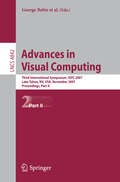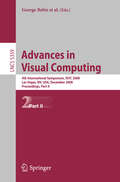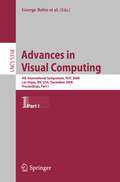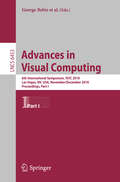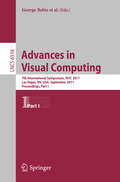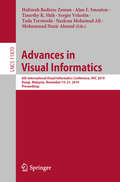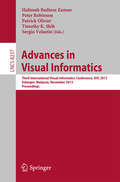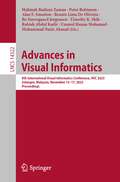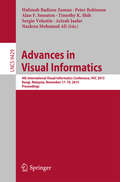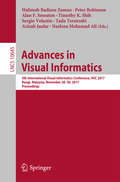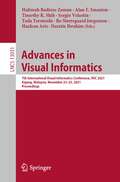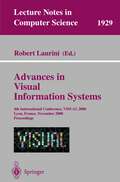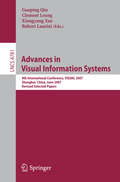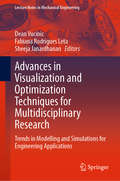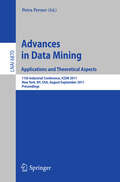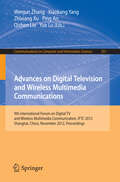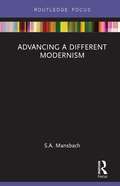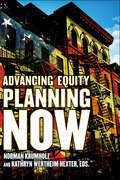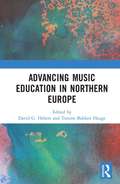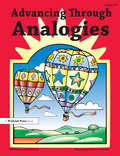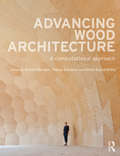- Table View
- List View
Advances in Visual Computing: Third International Symposium, ISVC 2007, Lake Tahoe, NV, USA, November 26-28, 2007, Proceedings, Part II (Lecture Notes in Computer Science #4842)
by Richard Boyle Bahram Parvin Darko Koracin Nikos Paragios Syeda-Mahmood Tanveer Tao Ju Zicheng Liu Sabine Coquillart Carolina Cruz-Neira Torsten Möller Tom MalzbenderThe two volume set LNCS 4841 and LNCS 4842 constitutes the refereed proceedings of the Third International Symposium on Visual Computing, ISVC 2007, held in Lake Tahoe, NV, USA, in November 2007. The 77 revised full papers and 42 poster papers presented together with 32 full and five poster papers of six special tracks were carefully reviewed and selected. The papers cover the four main areas of visual computing: vision, graphics, visualization, and virtual reality.
Advances in Visual Computing: 4th International Symposium, ISVC 2008, Las Vegas, NV, USA, December 1-3, 2008, Proceedings, Part II (Lecture Notes in Computer Science #5359)
by Richard Boyle Bahram Parvin Darko Koracin Fatih Porikli Jörg Peters James Klosowski Laura Arns Yu Ka Chun Theresa-Marie Rhyne Laura MonroeIt is with greatpleasure that we present the proceedings of the 4th International Symposium on Visual Computing (ISVC 2008) in Las Vegas, Nevada. ISVC o?ers a common umbrella for the four main areas of visual computing including vision, graphics, visualization, and virtual reality. Its goal is to provide a forum for researchers, scientists, engineers and practitioners throughout the world to present their latest research ?ndings, ideas, developments and applications in the broader area of visual computing. This year,ISVC grew signi?cantly; the programconsisted of 15 oralsessions, 1 poster session, 8 special tracks, and 6 keynote presentations. The response to the call for papers was very strong; we received over 340 submissions for the main symposium from which we accepted 102 papers for oral presentation and 70 papers for poster presentation. Special track papers were solicited separately through the Organizing and Program Committees of each track. A total of 56 papers were accepted for oral presentation and 8 papers for poster presentation in the special tracks. All papers were reviewed with an emphasis on potential to contribute to the state of the art in the ?eld. Selection criteria included accuracy and originality of ideas, clarity and signi?cance of results, and presentation quality. The review process was quite rigorous, involving two to three independent blind reviews followed by several days of discussion. During the discussion period we tried to correct anomalies and errors that might have existed in the initial reviews.
Advances in Visual Computing: 4th International Symposium, ISVC 2008, Las Vegas, NV, USA, December 1-3, 2008, Proceedings, Part I (Lecture Notes in Computer Science #5358)
by Richard Boyle Bahram Parvin Darko Koracin Fatih Porikli Theresa-Marie Rhyne Jörg Peters James Klosowski Laura Arns Yu Ka Chun Laura MonroeIt is with greatpleasure that we present the proceedings of the 4th International Symposium on Visual Computing (ISVC 2008) in Las Vegas, Nevada. ISVC o?ers a common umbrella for the four main areas of visual computing including vision, graphics, visualization, and virtual reality. Its goal is to provide a forum for researchers, scientists, engineers and practitioners throughout the world to present their latest research ?ndings, ideas, developments and applications in the broader area of visual computing. This year,ISVC grew signi?cantly; the programconsisted of 15 oralsessions, 1 poster session, 8 special tracks, and 6 keynote presentations. The response to the call for papers was very strong; we received over 340 submissions for the main symposium from which we accepted 102 papers for oral presentation and 70 papers for poster presentation. Special track papers were solicited separately through the Organizing and Program Committees of each track. A total of 56 papers were accepted for oral presentation and 8 papers for poster presentation in the special tracks. All papers were reviewed with an emphasis on potential to contribute to the state of the art in the ?eld. Selection criteria included accuracy and originality of ideas, clarity and signi?cance of results, and presentation quality. The review process was quite rigorous, involving two to three independent blind reviews followed by several days of discussion. During the discussion period we tried to correct anomalies and errors that might have existed in the initial reviews.
Advances in Visual Computing: 6th International Symposium, ISVC 2010, Las Vegas, NV, USA, November 29-December 1, 2010, Proceedings, Part I (Lecture Notes in Computer Science #6453)
by Daniel Thalmann Roger Crawfis Richard Boyle Bahram Parvin Darko Koracin Muhammad Hussain Ronald Chung Hammoud Kar-Han Tan David Kao Lisa AvilaIt is with great pleasure that we present the proceedings of the 6th Inter- tional, Symposium on Visual Computing (ISVC 2010), which was held in Las Vegas, Nevada. ISVC provides a common umbrella for the four main areas of visual computing including vision, graphics, visualization, and virtual reality. The goal is to provide a forum for researchers, scientists, engineers, and pr- titioners throughout the world to present their latest research ?ndings, ideas, developments, and applications in the broader area of visual computing. This year, the program consisted of 14 oral sessions, one poster session, 7 special tracks, and 6 keynote presentations. The response to the call for papers was very good; we received over 300 submissions for the main symposium from which we accepted 93 papers for oral presentation and 73 papers for poster p- sentation. Special track papers were solicited separately through the Organizing and Program Committees of each track. A total of 44 papers were accepted for oral presentation and 6 papers for poster presentation in the special tracks.
Advances in Visual Computing: 7th International Symposium, ISVC 2011, Las Vegas, NV, USA, September 26-28, 2011. Proceedings, Part I (Lecture Notes in Computer Science #6938)
by Song Wang George Bebis Richard Boyle Bahram Parvin Darko Koracin Kim Kyungnam Bedrich Benes Kenneth Moreland Christoph Borst Stephen DiVerdi Chiang Yi-Jen Jiang MingThe two volume set LNCS 6938 and LNCS 6939 constitutes the refereed proceedings of the 7th International Symposium on Visual Computing, ISVC 2011, held in Las Vegas, NV, USA, in September 2011. The 68 revised full papers and 46 poster papers presented together with 30 papers in the special tracks were carefully reviewed and selected from more than 240 submissions. The papers of part I (LNCS 6938) are organized in computational bioimaging, computer graphics, motion and tracking, segmentation, visualization; mapping modeling and surface reconstruction, biomedical imaging, computer graphics, interactive visualization in novel and heterogeneous display environments, object detection and recognition. Part II (LNCS 6939) comprises topics such as immersive visualization, applications, object detection and recognition, virtual reality, and best practices in teaching visual computing.
Advances in Visual Informatics: 6th International Visual Informatics Conference, IVIC 2019, Bangi, Malaysia, November 19–21, 2019, Proceedings (Lecture Notes in Computer Science #11870)
by Timothy K. Shih Halimah Badioze Zaman Alan F. Smeaton Sergio Velastin Nazlena Mohamad Ali Tada Terutoshi Mohammad Nazir AhmadThis book constitutes the refereed proceedings of the 6th International Conference on Advances in Visual Informatics, IVIC 2019, held in Bangi, Malaysia, in November 2019.The 65 papers presented were carefully reviewed and selected from 130 submissions. The papers are organized into the following topics: Visualization and Digital Innovation for Society 5.0; Engineering and Digital Innovation for Society 5.0; Cyber Security and Digital Innovation for Society 5.0; and Social Informatics and Application for Society 5.0.
Advances in Visual Informatics: Third International Visual Informatics Conference, IVIC 2013, Selangor, Malaysia, November 13-15, 2013, Proceedings (Lecture Notes in Computer Science #8237)
by Halimah Badioze Zaman Peter Robinson Patrick Olivier Timothy K. Shih Sergio VelastinThis book constitutes the refereed proceedings of the Third International Conference on Advances in Visual Informatics, IVIC 2013, held in Selangor, Malaysia, in November 2013. The four keynotes and 69 papers presented were carefully reviewed and selected from various submissions. The papers focus on four tracks: computer visions and engineering; computer graphics and simulation; virtual and augmented reality; and visualization and social computing.
Advances in Visual Informatics: 8th International Visual Informatics Conference, IVIC 2023, Selangor, Malaysia, November 15–17, 2023, Proceedings (Lecture Notes in Computer Science #14322)
by Halimah Badioze Zaman Peter Robinson Alan F. Smeaton Renato Lima De Oliveira Bo Nørregaard Jørgensen Timothy K. Shih Rabiah Abdul Kadir Ummul Hanan Mohamad Mohammad Nazir AhmadThis book constitutes the refereed proceedings of the 8th International Conference on Advances in Visual Informatics, IVIC 2023, held in Selangor, Malaysia in November 2023.The 51 full papers presented were carefully reviewed and selected from 101 submissions. The conference focused on 6 tracks: Modeling and Simulation, Mixed Reality and HCI, Systems Integration and IoT, Cybersecurity, Energy Informatics and Intelligent Data Analytics.
Advances in Visual Informatics: 4th International Visual Informatics Conference, IVIC 2015, Bangi, Malaysia, November 17-19, 2015, Proceedings (Lecture Notes in Computer Science #9429)
by Halimah Badioze Zaman Peter Robinson Alan F. Smeaton Timothy K. Shih Sergio Velastin Azizah Jaafar Nazlena Mohamad AliThis book constitutes the refereed proceedings of the Fourth International Conference on Advances in Visual Informatics, IVIC 2015, held in Bangi, Malaysia, in November 2015.The five keynotes and 45 papers presented were carefully reviewed and selected from 82 initial submissions. The papers are organized in four tracks on visualization and big data; machine learning and computer vision; computer graphics; as well as virtual reality.
Advances in Visual Informatics: 5th International Visual Informatics Conference, IVIC 2017, Bangi, Malaysia, November 28–30, 2017, Proceedings (Lecture Notes in Computer Science #10645)
by Halimah Badioze Zaman Peter Robinson Alan F. Smeaton Timothy K. Shih Sergio Velastin Tada Terutoshi Azizah Jaafar Nazlena Mohamad AliThis book constitutes the refereed proceedings of the 5th International Conference on Advances in Visual Informatics, IVIC 2017, held in Bangi, Malaysia, in November 2017. The keynote and 72 papers presented were carefully reviewed and selected from 130 submissions. The papers are organized in the following topics: Visualization and Data Driven Technology; Engineering and Data Driven Innovation; Data Driven Societal Well-being and Applications; and Data Driven Cyber Security.
Advances in Visual Informatics: 7th International Visual Informatics Conference, IVIC 2021, Kajang, Malaysia, November 23–25, 2021, Proceedings (Lecture Notes in Computer Science #13051)
by Halimah Badioze Zaman Alan F. Smeaton Timothy K. Shih Sergio Velastin Tada Terutoshi Bo Nørregaard Jørgensen Hazleen Aris Nazrita IbrahimThis book constitutes the refereed proceedings of the 7th International Conference on Advances in Visual Informatics, IVIC 2021, held in Selangor, Malaysia in November 2021. The 59 papers presented were carefully reviewed and selected from 114 submissions. The papers are organized into the following topics: Visualization and Digital Innovation; Engineering and Digital Innovation; Cyber Security and Digital Innovation; and Energy Informatics and Digital Innovation.
Advances in Visual Information Systems: 4th International Conference, VISUAL 2000, Lyon, France, November 2-4, 2000 Proceedings (Lecture Notes in Computer Science #1929)
by Robert LauriniPresently, in our world, visual information dominates. The turn of the millenium marks the age of visual information systems. Enabled by picture sensors of all kinds turning digital, visual information will not only enhance the value of existing information, it will also open up a new horizon of previously untapped information sources. There is a huge demand for visual information access from the consumer. As well, the handling of visual information is boosted by the rapid increase of hardware and Internet capabilities. Advanced technology for visual information systems is more urgently needed than ever before: not only new computational methods to retrieve, index, compress and uncover pictorial information, but also new metaphors to organize user interfaces. Also, new ideas and algorithms are needed which allow access to very large databases of digital pictures and videos. Finally we should not forget new systems with visual interfaces integrating the above components into new types of image, video or multimedia databases and hyperdocuments. All of these technologies will enable the construction of systems that are radically different from conventional information systems. Many novel issues will need to be addressed: query formulation for pictorial information, consistency management thereof, indexing and assessing the quality of these systems. Historically, the expression Visual Information Systems can be understood either as a system for image information or as visual system for any kind information.
Advances in Visual Information Systems: 9th International Conference, VISUAL 2007 Shanghai, China, June 28-29, 2007 Revised Selected Papers (Lecture Notes in Computer Science #4781)
by Xiang-Yang Xue Robert Laurini Guoping Qiu Clement LeungThis book constitutes the thoroughly refereed post-proceedings of the 9th International Conference on Visual Information Systems, VISUAL 2007, held in Shanghai, China, in June 2007. The papers are organized in topical section on image and video retrieval, visual biometrics, intelligent visual information processing, visual data mining, ubiquitous and mobile visual information systems, semantics, 2D/3D graphical visual data retrieval, and applications of visual information systems.
Advances in Visualization and Optimization Techniques for Multidisciplinary Research: Trends in Modelling and Simulations for Engineering Applications (Lecture Notes in Mechanical Engineering)
by Dean Vucinic Fabiana Rodrigues Leta Sheeja JanardhananThis volume presents several multidisciplinary approaches to the visual representation of data acquired from experiments. As an expansion of these approaches, it is also possible to include data examination generated by mathematical-physical modeling. Imaging Systems encompass any subject related to digital images, from fundamental requirements for a correct image acquisition to computational algorithms that make it possible to obtain relevant information for image analysis. In this context, the book presents selected contributions of a special session at the Conference on Advanced Computational Engineering and Experimenting (ACE-X) 2016.
Advances on Data Mining: 11th Industrial Conference, ICDM 2011, New York, NY, USA, August 30 – September 3, 2011, Proceedings (Lecture Notes in Computer Science #6870)
by Petra PErnerThis book constitutes the refereed proceedings of the 11th Industrial Conference on Data Mining, ICDM 2011, held in New York, USA in September 2011. The 22 revised full papers presented were carefully reviewed and selected from 100 submissions. The papers are organized in topical sections on data mining in medicine and agriculture, data mining in marketing, data mining for Industrial processes and in telecommunication, Multimedia Data Mining, theoretical aspects of data mining, Data Warehousing, WebMining and Information Mining.
Advances on Digital Television and Wireless Multimedia Communications: 9th International Forum on Digital TV and Wireless Multimedia Communication, IFTC 2012, Shanghai, China, November 9-10, 2012. Proceedings (Communications in Computer and Information Science #331)
by Ping An Qizhen Liu Yue Lu Wenjun Zhang Xiaokang Yang Zhixiang XuThis book constitutes the refereed proceedings of the 9th International Forum on Digital TV and Wireless Multimedia Communication, IFTC 2012, Shanghai, China, November. The 69 revised full papers presented were carefully reviewed and selected from numerous submissions. The papers are organized in topical sections on image processing and pattern recognition; image and video analysis; image quality assessment; text image and speech processing; content retrieval and security; source coding; multimedia communication; new advances in broadband multimedia; human computer interface; 3D video.
Advancing a Different Modernism (Routledge Focus on Art History and Visual Studies)
by S.A. MansbachAdvancing a Different Modernism analyzes a long-ignored but formative aspect of modern architecture and art. By examining selective buildings by the Catalan architect Lluís Domènech i Montaner (1850-1923) and by the Slovenian designer Jože Plecnik (1872-1957), the book reveals the fundamental political and ideological conservatism that helped shape modernism’s history and purpose. This study thus revises the dominant view of modernism as a union of progressive forms and progressive politics. Instead, this innovative volume promotes a nuanced and critical consideration of how architecture was creatively employed to advance radically new forms and methods, while simultaneously consolidating an essentially conservative nationalist self-image.
Advancing a Different Modernism (Routledge Focus on Art History and Visual Studies)
by S.A. MansbachAdvancing a Different Modernism analyzes a long-ignored but formative aspect of modern architecture and art. By examining selective buildings by the Catalan architect Lluís Domènech i Montaner (1850-1923) and by the Slovenian designer Jože Plecnik (1872-1957), the book reveals the fundamental political and ideological conservatism that helped shape modernism’s history and purpose. This study thus revises the dominant view of modernism as a union of progressive forms and progressive politics. Instead, this innovative volume promotes a nuanced and critical consideration of how architecture was creatively employed to advance radically new forms and methods, while simultaneously consolidating an essentially conservative nationalist self-image.
Advancing Equity Planning Now
by Edited by Norman Krumholz and Kathryn Wertheim HexterWhat can planners do to restore equity to their craft? Drawing upon the perspectives of a diverse group of planning experts, Advancing Equity Planning Now places the concepts of fairness and equal access squarely in the center of planning research and practice. Editors Norman Krumholz and Kathryn Wertheim Hexter provide essential resources for city leaders and planners, as well as for students and others, interested in shaping the built environment for a more just world.Advancing Equity Planning Now remind us that equity has always been an integral consideration in the planning profession. The historic roots of that ethical commitment go back more than a century. Yet a trend of growing inequality in America, as well as other recent socio-economic changes that divide the wealthiest from the middle and working classes, challenge the notion that a rising economic tide lifts all boats. When planning becomes mere place-making for elites, urban and regional planners need to return to the fundamentals of their profession. Although they have not always done so, planners are well-positioned to advocate for greater equity in public policies that address the multiple objectives of urban planning including housing, transportation, economic development, and the removal of noxious land uses in neighborhoods.Thanks to generous funding from Cleveland State University, the ebook editions of this book are available as Open Access volumes from Cornell Open (cornellopen.org) and other repositories.
Advancing Music Education in Northern Europe
by David G. Hebert Torunn Bakken HaugeAdvancing Music Education in Northern Europe tells the story of a unique organization that has contributed in profound ways to the professional development of music teachers in the Nordic and Baltic nations. At the same time, the book offers reflections on how music education and approaches to the training of music teachers have changed across recent decades, a period of significant innovations. In a time where international partnerships appear to be threatened by a recent resurgence in protectionism and nationalism, this book also more generally demonstrates the value of formalized international cooperation in the sphere of higher education. The setting for the discussion, Northern Europe, is a region arguably of great importance to music education for a number of reasons, seen, for instance, in Norway’s ranking as the “happiest nation on earth”, the well-known success of Finland’s schools in international-comparative measures of student achievement, how Sweden has grappled with its recent experience as “Europe’s top recipient of asylum seekers per capita”, and Estonia’s national identity as a country born from a “Singing Revolution”, to name but a few examples. The contributors chronicle how the Nordic Network for Music Education (NNME) was founded and developed, document its impact, and demonstrate how the eight nations involved in this network – Norway, Iceland, Denmark, Sweden, Finland, Estonia, Latvia, and Lithuania – are making unique contributions of global significance to the field of music education.
Advancing Music Education in Northern Europe
by David G. Hebert Torunn Bakken HaugeAdvancing Music Education in Northern Europe tells the story of a unique organization that has contributed in profound ways to the professional development of music teachers in the Nordic and Baltic nations. At the same time, the book offers reflections on how music education and approaches to the training of music teachers have changed across recent decades, a period of significant innovations. In a time where international partnerships appear to be threatened by a recent resurgence in protectionism and nationalism, this book also more generally demonstrates the value of formalized international cooperation in the sphere of higher education. The setting for the discussion, Northern Europe, is a region arguably of great importance to music education for a number of reasons, seen, for instance, in Norway’s ranking as the “happiest nation on earth”, the well-known success of Finland’s schools in international-comparative measures of student achievement, how Sweden has grappled with its recent experience as “Europe’s top recipient of asylum seekers per capita”, and Estonia’s national identity as a country born from a “Singing Revolution”, to name but a few examples. The contributors chronicle how the Nordic Network for Music Education (NNME) was founded and developed, document its impact, and demonstrate how the eight nations involved in this network – Norway, Iceland, Denmark, Sweden, Finland, Estonia, Latvia, and Lithuania – are making unique contributions of global significance to the field of music education.
Advancing Through Analogies: Grades 5-8
by Lynne ChathamYou can easily build your students' critical thinking and vocabulary skills with these fun analogy activities. Teaching students to solve analogies not only develops analogical thinking, but it also helps students learn and apply vocabulary skills. An analogy is a comparison between two things. It points out the similarities or likenesses between things that might be different in all other respects.The exercises included in this resource not only build thinking skills and make students more flexible and analytical, but they also enhance vocabulary and writing skills. Each illustrated page presents several analogy types along with examples of each type. Review pages give students an opportunity to identify and then solve a variety of analogies. The activities in this book will challenge students to think more critically and apply advanced vocabulary.This book introduces 16 different types of analogies, including: synonyms (calm : serene),part to whole (ring : jewelry),place or location (Peru : South America),cause and effect (fire : smoke),action to object (cut : scissors), andcharacteristics (ruby : red). These challenging activities are perfect for teaching analytical thinking, enhancing vocabulary, and improving writing skills. Advancing Through Analogies is the most advanced book in a series from Prufrock that introduces analogies to young thinkers. While the activity books in the series for younger students emphasize visual and symbolic analogies, this book for older students emphasizes verbal analogies. For easier analogies, see Thinking Through Analogies, Analogies for the 21st Century, Analogies for Beginners, and First Time Analogies. Grades 5-8
Advancing Through Analogies: Grades 5-8
by Lynne ChathamYou can easily build your students' critical thinking and vocabulary skills with these fun analogy activities. Teaching students to solve analogies not only develops analogical thinking, but it also helps students learn and apply vocabulary skills. An analogy is a comparison between two things. It points out the similarities or likenesses between things that might be different in all other respects.The exercises included in this resource not only build thinking skills and make students more flexible and analytical, but they also enhance vocabulary and writing skills. Each illustrated page presents several analogy types along with examples of each type. Review pages give students an opportunity to identify and then solve a variety of analogies. The activities in this book will challenge students to think more critically and apply advanced vocabulary.This book introduces 16 different types of analogies, including: synonyms (calm : serene),part to whole (ring : jewelry),place or location (Peru : South America),cause and effect (fire : smoke),action to object (cut : scissors), andcharacteristics (ruby : red). These challenging activities are perfect for teaching analytical thinking, enhancing vocabulary, and improving writing skills. Advancing Through Analogies is the most advanced book in a series from Prufrock that introduces analogies to young thinkers. While the activity books in the series for younger students emphasize visual and symbolic analogies, this book for older students emphasizes verbal analogies. For easier analogies, see Thinking Through Analogies, Analogies for the 21st Century, Analogies for Beginners, and First Time Analogies. Grades 5-8
Advancing Wood Architecture: A Computational Approach
by Achim Menges Tobias Schwinn Oliver David KriegIn light of environmental challenges architecture is facing, wood is no longer regarded as outmoded, nostalgic, and rooted in the past, but increasingly recognized as one of the most promising building materials for the future. Recent years have seen unprecedented innovation of new technologies for advancing wood architecture. Advancing Wood Architecture offers a comprehensive overview of the new architectural possibilities that are enabled by cutting-edge computational technologies in wood construction. It provides both an overarching architectural understanding and in-depth technological information through built projects and the works of four leading design research groups in Europe. The projects presented include large scale, permanent buildings such as the ETH Arch-Tec Lab Building in Zurich, the Landesgartenschau Exhibition Hall near Stuttgart and the Boiler House in Hooke Park, UK, as well as, built research prototypes investigating additive robotic fabrication, folded plate structures and meteorosensitive building skins. Illustrated in full colour, the book showcases the latest technological developments in design computation, simulation and digital fabrication together with an architectural, engineering and manufacturing perspective, offering an outlook towards novel spatial and constructional opportunities of a material with unrivalled ecological virtues.
Advancing Wood Architecture: A Computational Approach
by Achim Menges Tobias Schwinn Oliver David KriegIn light of environmental challenges architecture is facing, wood is no longer regarded as outmoded, nostalgic, and rooted in the past, but increasingly recognized as one of the most promising building materials for the future. Recent years have seen unprecedented innovation of new technologies for advancing wood architecture. Advancing Wood Architecture offers a comprehensive overview of the new architectural possibilities that are enabled by cutting-edge computational technologies in wood construction. It provides both an overarching architectural understanding and in-depth technological information through built projects and the works of four leading design research groups in Europe. The projects presented include large scale, permanent buildings such as the ETH Arch-Tec Lab Building in Zurich, the Landesgartenschau Exhibition Hall near Stuttgart and the Boiler House in Hooke Park, UK, as well as, built research prototypes investigating additive robotic fabrication, folded plate structures and meteorosensitive building skins. Illustrated in full colour, the book showcases the latest technological developments in design computation, simulation and digital fabrication together with an architectural, engineering and manufacturing perspective, offering an outlook towards novel spatial and constructional opportunities of a material with unrivalled ecological virtues.
